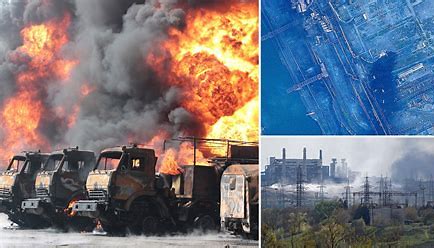
As Western countries ship increasingly heavy arms to a beleaguered Ukraine, one of the most important transfers so far is an arsenal’s worth of field howitzers. Unlike the Ukrainian army’s existing big guns, these artillery pieces come in Nato calibres and are the key to unlocking the West’s precision-guided artillery technology.
The technology, which includes GPS-guided artillery shells and tank-hunting munitions, could make Ukraine’s cannon-cockers exponentially more powerful.
Ukraine’s army has halted Russia’s advance into the country, and in some cases – like northwest of Kyiv – even sent the Russian Ground Forces scurrying back across the border. The Ukrainians have relied heavily on field artillery to hold off Russia’s invasion and consider it their most effective weapon.
A recent study from the United Kingdom-based Royal United Services Institute cites a Ukrainian military official as saying “anti-tank missiles slowed the Russians down, but what killed them was our artillery. That was what broke their units.”
The Ukrainian Ground Forces have a considerable number of artilleries, both traditional tube and rocket artillery. The total includes 2S3 Akatsiya 152-millimeter and 2S1 122-millimeter Gvozdika self-propelled howitzers; 122-millimeter BM-21 Grad truck-mounted multiple launch rocket systems; and D-20 152-millimeter and D-30 122-millimeter towed artillery pieces. Although theoretically numerous, the pieces are almost all old, produced by the Soviet Union before its collapse in 1991. The guns are also produced in Soviet-era calibres, which a dwindling number of countries (including Russia and Ukraine) continue to operate.
Nato forces, on the other hand, use standardised 155 millimetre artillery shells. Those three millimetres make a world of a difference, rendering Western and Soviet-derived shells incompatible with one another. But now, as the West grows bolder in sending advanced weapons, Ukraine is set to receive more than 100 155-millimeter artillery pieces.
The United States is slated to send 90 M777 towed howitzers, the current towed artillery piece in use by the U.S. Army and Marine Corps; Australia is sending six M777s, and Canada is sending four. The Netherlands has promised six Pz2000 155-millimeter self-propelled howitzers, while France will send between 10 and 12 CAESAR truck-mounted 155s.
These howitzers have powerful implications for Ukraine’s hitting power. Ukraine’s current artillery pieces are at least three decades old, have fairly short ranges, and with the exception of Ukraine’s Kvitnyk laser-guided artillery shells, are unable to take advantage of the last four decades of technological progress and innovation.
All of the donated pieces, by contrast, were developed and fielded long after Ukraine’s entire artillery fleet was already built. The Soviet-era 2S3 Akatsiya self-propelled howitzer has a range of 10.5 miles and can fire up to three 152-millimeter rounds per minute. By comparison, the French CAESAR self-propelled howitzer has a range of nearly 25 miles and can fire up to six rounds per minute.
Ukraine will almost certainly get Western precision-guided rounds as part of the package. The American-developed M982 and M982A1 Excalibur artillery shells can home in on a set of GPS coordinates, and unlike artillery of the past, can hit a target with the first round. Excalibur is so precise, the U.S. Army claims, it will hit within two meters of the target “regardless of range.” This level of accuracy will allow Ukrainian artillerymen to hit more targets faster and without so-called “collateral damage” to civilians still living in combat areas.
Excalibur will allow Ukrainian forces to take out enemy forces quickly and more efficiently than ever before a major asset for a defending force that might find itself outnumbered. A Bayraktar-type drone, for example, could act as a spotter for an Excalibur-armed artillery unit, locating dozens of enemy targets in a single sortie and sending back GPS coordinates for nearby artillerymen to service.
Excalibur could take out stationary enemy vehicles one at a time, or even rain down a curtain of well-placed explosive shells along a trench line of enemy troops. A target that might take one battery of six howitzers to destroy might well just take one Excalibur-armed howitzer to destroy.
Another round likely winging its way to Ukraine is the UK/French BONUS artillery shell. BONUS was developed for one thing and one thing only: to kill tanks and other armoured vehicles. BONUS, once fired from the muzzle of a howitzer, flies downrange and ejects two smart submunitions. The two submunitions use a multispectral sensor package to detect enemy armour across an area of up to 32,000 meters. Once an enemy tank or armoured vehicle is detected, the submunition fires a self-forging warhead that lances down through the top of the vehicle, penetrating the thin armour and destroying it.
BAE Systems, which is in the process of supplying BONUS to the U.S. Army, says one shell will on average take out one target. Imagine a Russian tank company of ten tanks advancing across an open Ukrainian field. A nearby battery of six M777 howitzers responds to the attack, firing six BONUS at the column.
The Russian tank company could lose up to six tanks in a single salvo, instantly rendering the company combat ineffective. BONUS would be devastating against Russian artillery units in firing positions, seeking out and destroying howitzers, ammunition carriers, and headquarters vehicles alike.
The United States and its allies believe Ukraine can win, as Secretary of Defence Lloyd Austin said late last month. The new generation of field artillery on its way to Ukraine, as well as an equally new generation of smart shells, will go a long way toward victory for Kyiv. Russia has faced serious setbacks in its “special military operation,” many of its own making, but the hurt inflicted by Ukraine’s new artillery could cause the Russian Army a whole different level of pain.











